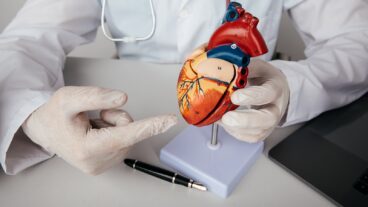A temporary tattoo that electronically measures the activity of muscle and nerve cells could revolutionize medicine, rehabilitation and even business and marketing research, predict its developers from Tel Aviv University’s Center for Nanoscience and Nanotechnology.
The carbon electrodes are screen-printed on temporary tattoo film backed with an adhesive surface that attaches to the skin. A nanotechnology-based conductive polymer coating enhances the electrode’s performance. The device records a strong, steady signal for hours on end without irritating the skin.
“Our tattoo permits patients to carry on with their daily routines, while the electrode monitors their muscle and nerve activity. The idea is: stick it on and forget about it,” said Prof. Yael Hanein, head of the center.
The device was first developed as an alternative to electromyography, a test that assesses the health of muscles and nerve cells.
This uncomfortable and unpleasant medical procedure requires patients to lie still in the lab for hours on end. Often a needle is stuck into muscle tissue to record its electrical activity, or patients are swabbed with a cold, sticky gel and attached to surface electrodes.

Hanein said the new skin electrode will be used to monitor the muscle activity of patients with neurodegenerative diseases in a study at Tel Aviv Medical Center.
“The physiological data measured in specific muscles may be used in the future to indicate the alertness of drivers on the road,” she said. “Patients in rehabilitation following stroke or brain injury may utilize the ‘tattoo’ to improve muscle control; and amputees may employ it to move artificial limbs with remaining muscles.”
Window into emotional state
Aside from improving the therapeutic restoration of damaged nerves and tissues, the novel device could even lead to new insights into emotions.
“One major application of the new electrode is the mapping of emotion by monitoring facial expressions through electric signals received from facial muscles,” Hanein said.
For example, it could reveal if someone’s smile is real or faked.
The ability to identify and map people’s emotions has many potential uses, she continued.
“Advertisers, pollsters, media professionals, and others all want to test people’s reactions to various products and situations. Today, with no accurate scientific tools available, they rely mostly on inevitably subjective questionnaires. Researchers worldwide are trying to develop methods for mapping emotions by analyzing facial expressions, mostly via photos and smart software.
“But our skin electrode provides a more direct and convenient solution.”
Hanein reported on the invention with co-authors Lilach Bareket, Lilah Inzelberg, David Rand, Moshe David-Pur, David Rabinovich and Barak Brandesin Scientific Reports.
She also gave a presentation about the tattoo at an international nanomedicine program held at the university.
The development of the electrode was part of a European Research Council project and received support from the BSMT Consortium of Israel’s Ministry of Economy and Industry.
















